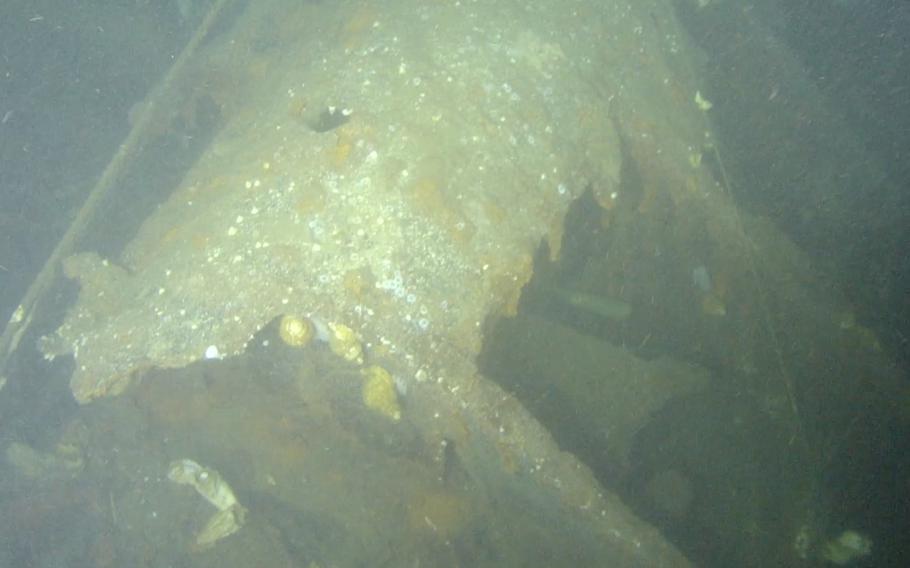The USS Albacore off Groton, Conn., in May 1942. Note the large conning tower and periscope sheers. (U.S. Navy History and Heritage Command)
The long-lost wreckage of a U.S. Navy submarine credited with sinking nearly a dozen enemy ships during World War II before vanishing in late 1944 has been found off the coast of northern Japan, Navy officials announced Thursday.
The USS Albacore’s wreckage was confirmed by the Naval History and Heritage Command’s Underwater Archaeology Branch after it was located recently off the coast of Hokkaido, the northernmost of Japan’s main islands, the Navy said in a news release. The NHHC used information and imagery provided by Tamaki Ura, a University of Tokyo professor who has specialized in developing autonomous underwater vehicles to confirm the identity of the submarine. The Albacore disappeared while patrolling in the Pacific Ocean and had at least 85 sailors aboard.
“As the final resting place for [U.S.] sailors who gave their life in defense of our nation, we sincerely thank and congratulate Dr. Ura and his team for their efforts in locating the wreck of Albacore,” Samuel Cox, the director of the NHHC, said in a statement. “It is through their hard work and continued collaboration that we could confirm Albacore’s identity after being lost at sea for over 70 years.”
The Albacore was last heard from by the U.S. military on Oct. 28, 1944, when it stopped at Midway for fuel en route for its 11th combat patrol in the waters off northern Japan, according to Naval records. The Gato-class submarine was believed sunk in a Nov. 7, 1944, underwater explosion reported in Japanese military records, likely the result of hitting an underwater mine. The location of the ship’s wreckage appeared to confirm those details, according to the Navy.

A screenshot of the wreck site of the USS Albacore, which was lost at sea Nov. 7, 1944. Indications of documented modifications made to Albacore prior to her final patrol such as the presence of an SJ Radar dish and mast, a row of vent holes along the top of the superstructure, and the absence of steel plates along the upper edge of the fairwater allowed Naval History and Heritage Command to confirm the wreck site finding as the Albacore. The screenshot was captured from video courtesy of Tamaki Ura from the University of Tokyo. (Abigayle Lutz/Naval History and Heritage Command)
Before the sub’s sinking, the Albacore had proved a capable warship. The vessel was built by the Electric Boat Company and commissioned into the Navy on June 1, 1942. The Navy credited the submarine with sinking at least 10 enemy ships during its brief tenure — earning the Albacore nine battle stars for meritorious participation in battle and four Presidential Unit Citations for extraordinary heroism in combat. The Navy said the Albacore might have been responsible for sinking three additional ships during the war, but those have not been confirmed.
Among the sub’s known sinkings were Japanese destroyers, freighters and the 31,000-ton Japanese aircraft carrier Taiho, then the newest and largest carrier in the Japanese fleet. Taiho sunk hours after being struck by a torpedo fired by the Albacore during the Battle of the Philippine Sea, according to the Navy. The Albacore’s crew did not know at the time that they had sunk the flagship after diving deep to escape incoming aerial attacks. Months later, the Albacore’s top officer at that time, Lt. Cmdr. James Blanchard, was awarded the Navy Cross, the service’s second-highest honor for combat heroics, for his role in sinking the Taiho.
The Navy said Ura used unmanned underwater craft to locate the Albacore based on Japanese records documenting the Nov. 7, 1944, explosion off Hokkaido.
“Strong currents, marine growth and poor visibility on site made it challenging to fully document the wreck or obtain comprehensive images,” the Navy statement said. “However, several key features of a late 1944 Gato-class submarine were identified in the video.”
Those features included the presence of a SJ Radar dish and mast, a row of vent holes along the top of the superstructure and the absence of steel plates along the ship’s upper edge consistent with the Albacore’s construction at the time that the submarine was last seen, according to the Navy.
The Albacore’s wreckage now falls under the NHHC’s jurisdiction and is protected from intrusion by U.S. law, the Navy said.
“The wreck represents the final resting place of sailors that gave their life in defense of the nation and should be respected by all parties as a war grave,” the Navy statement reads.